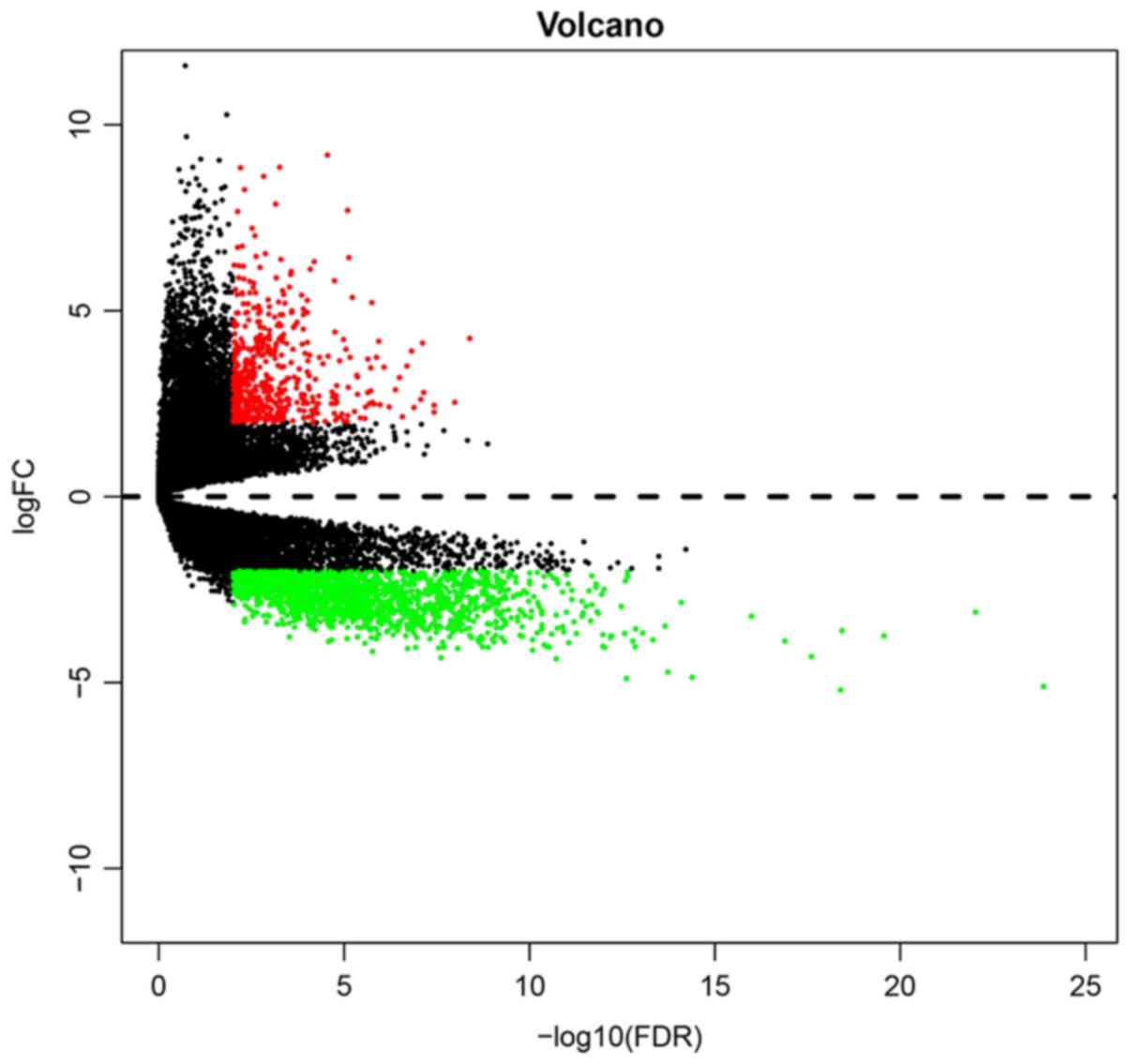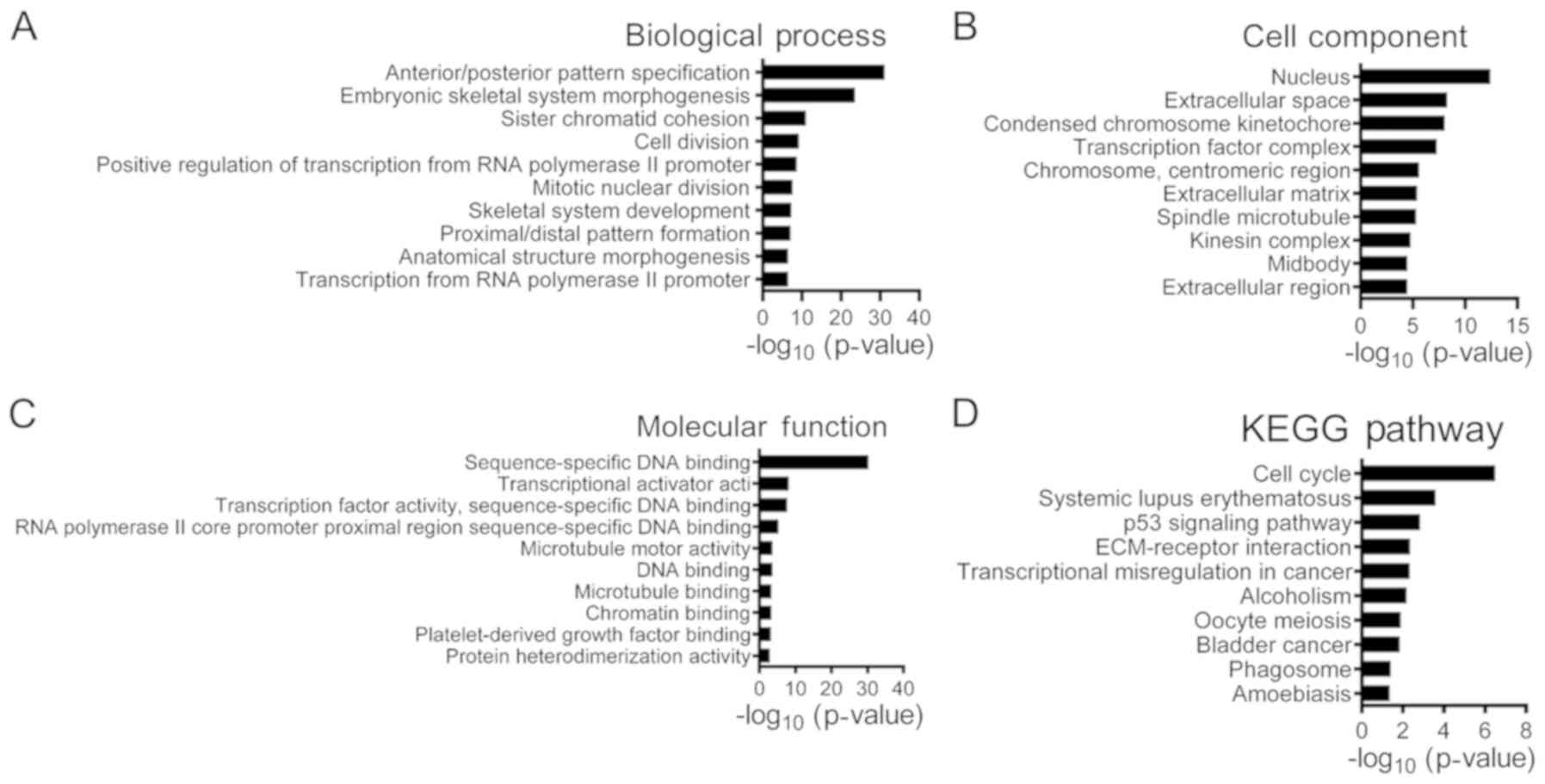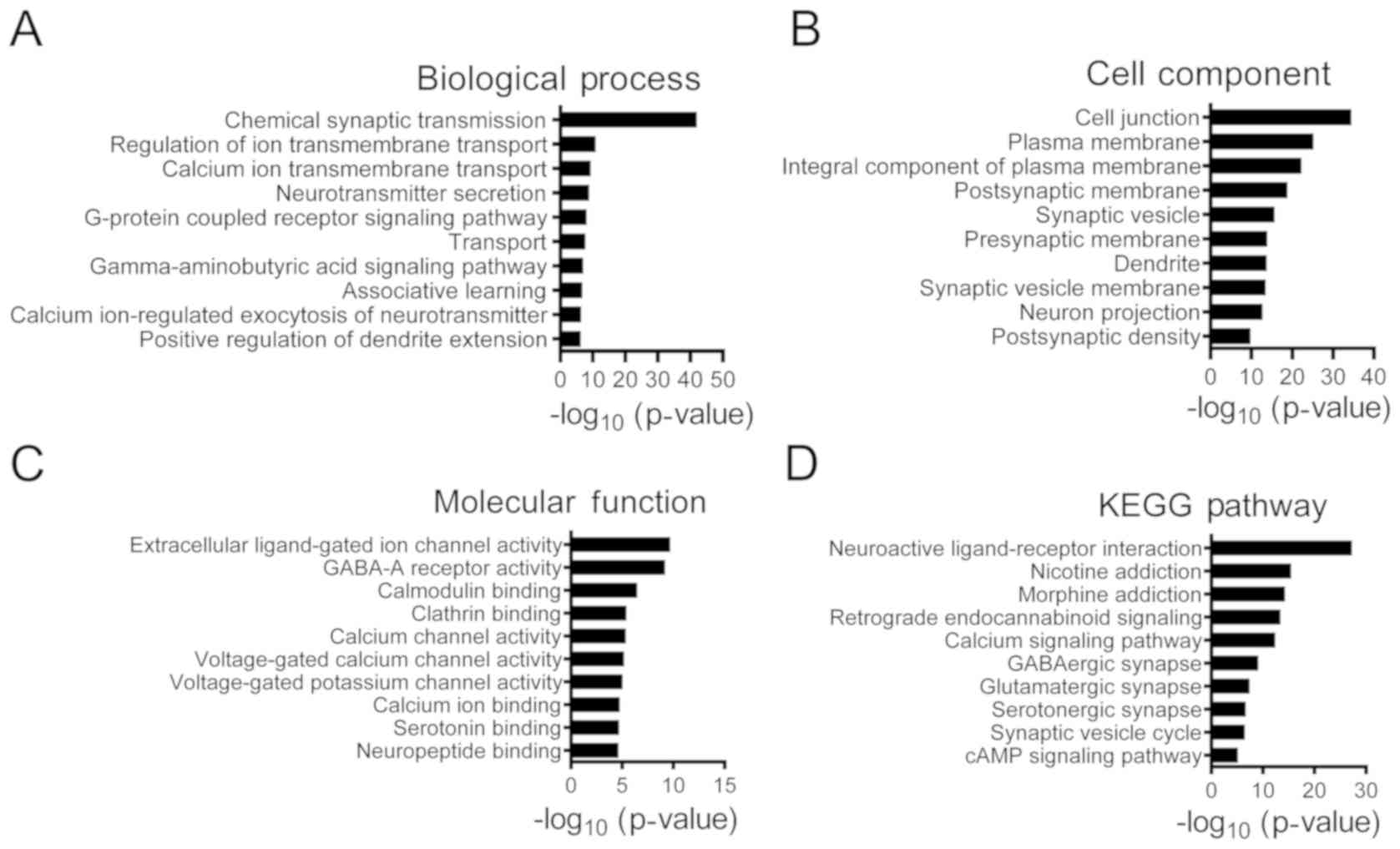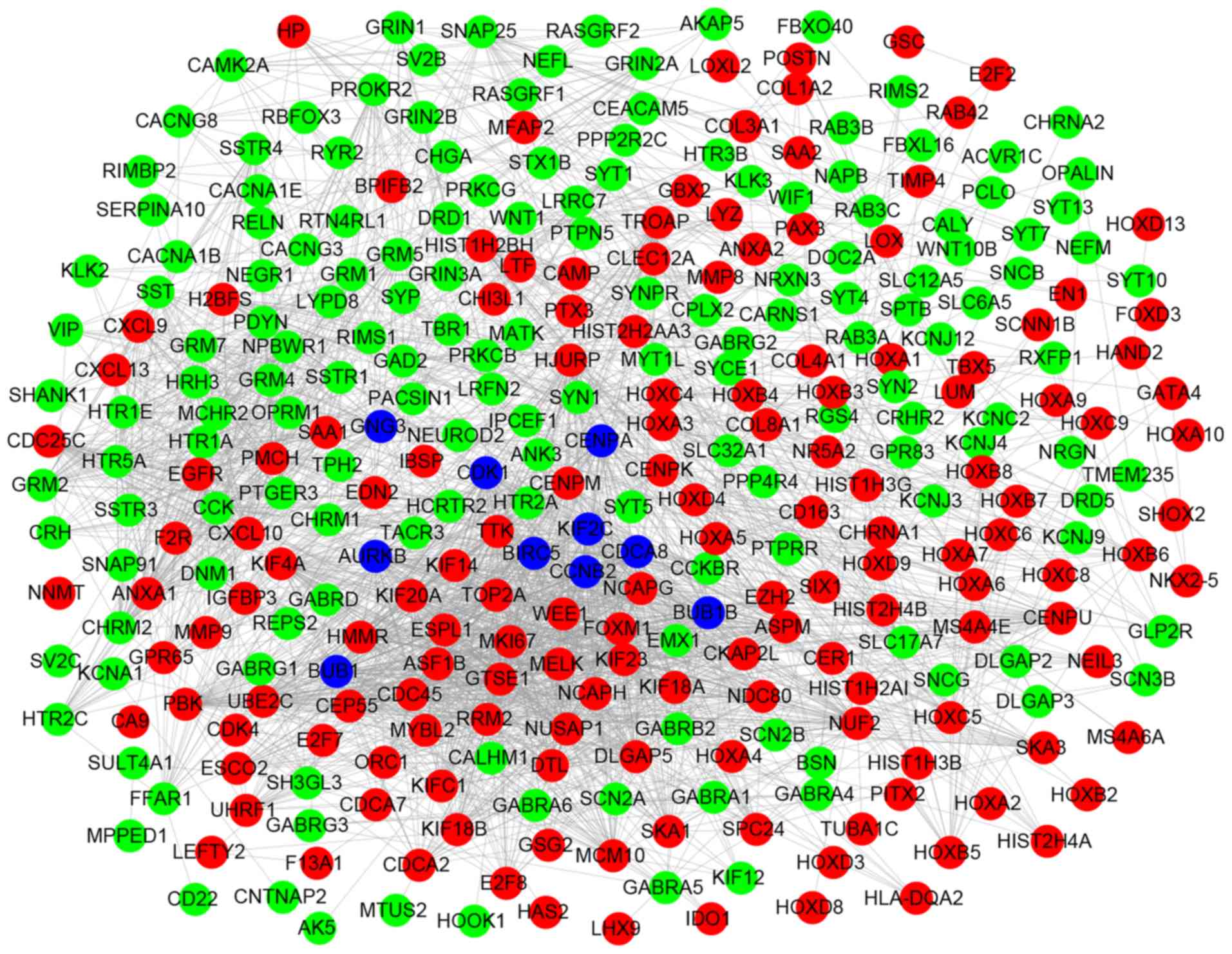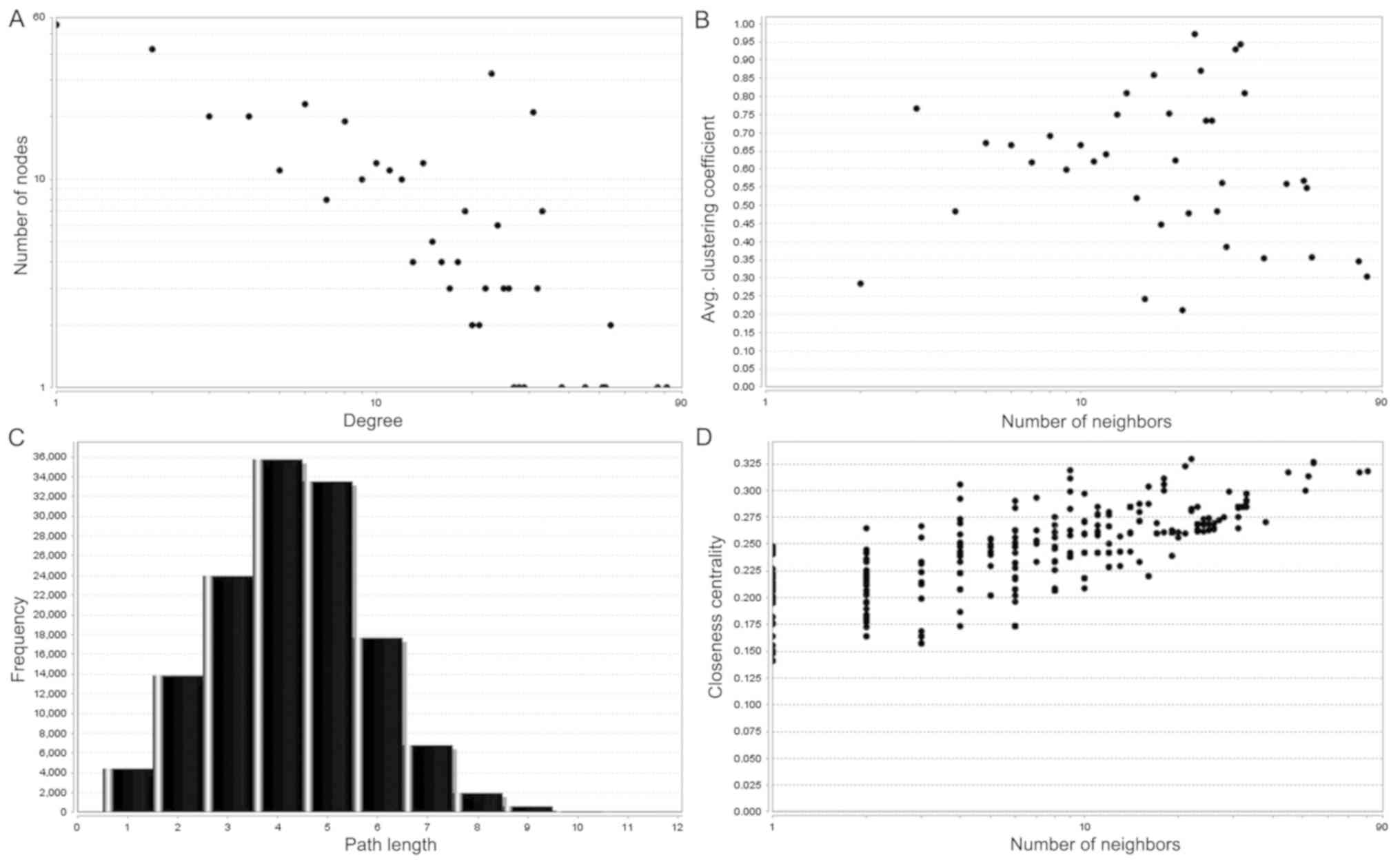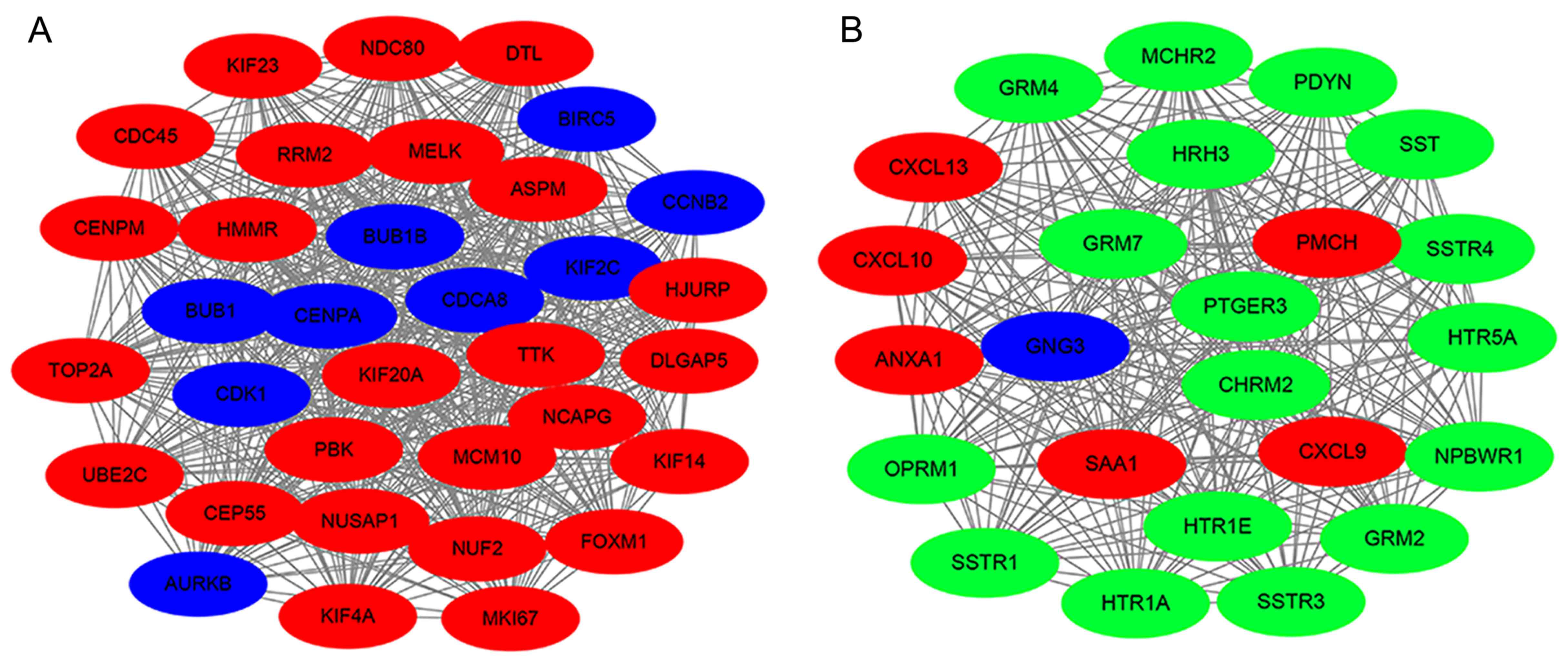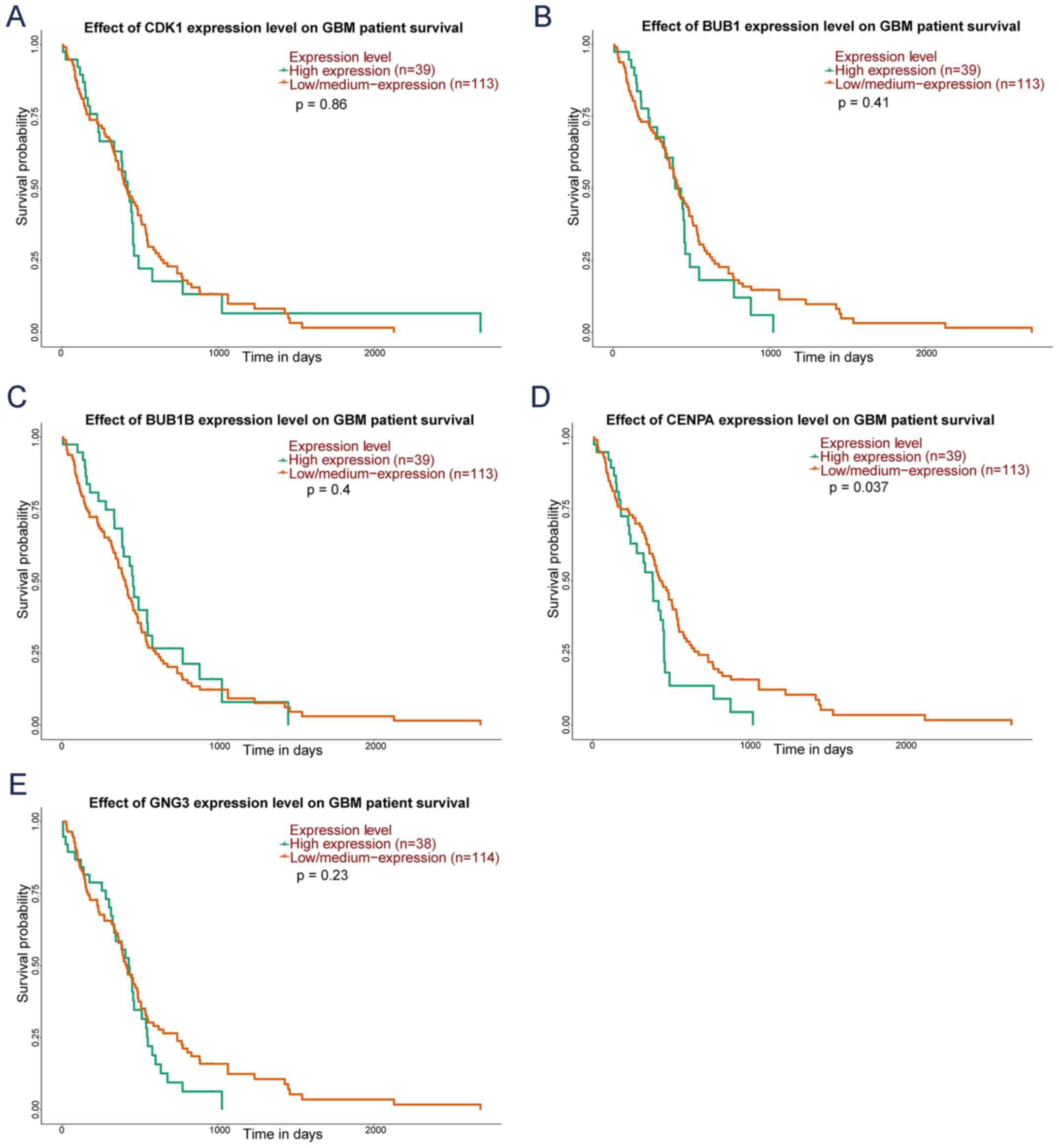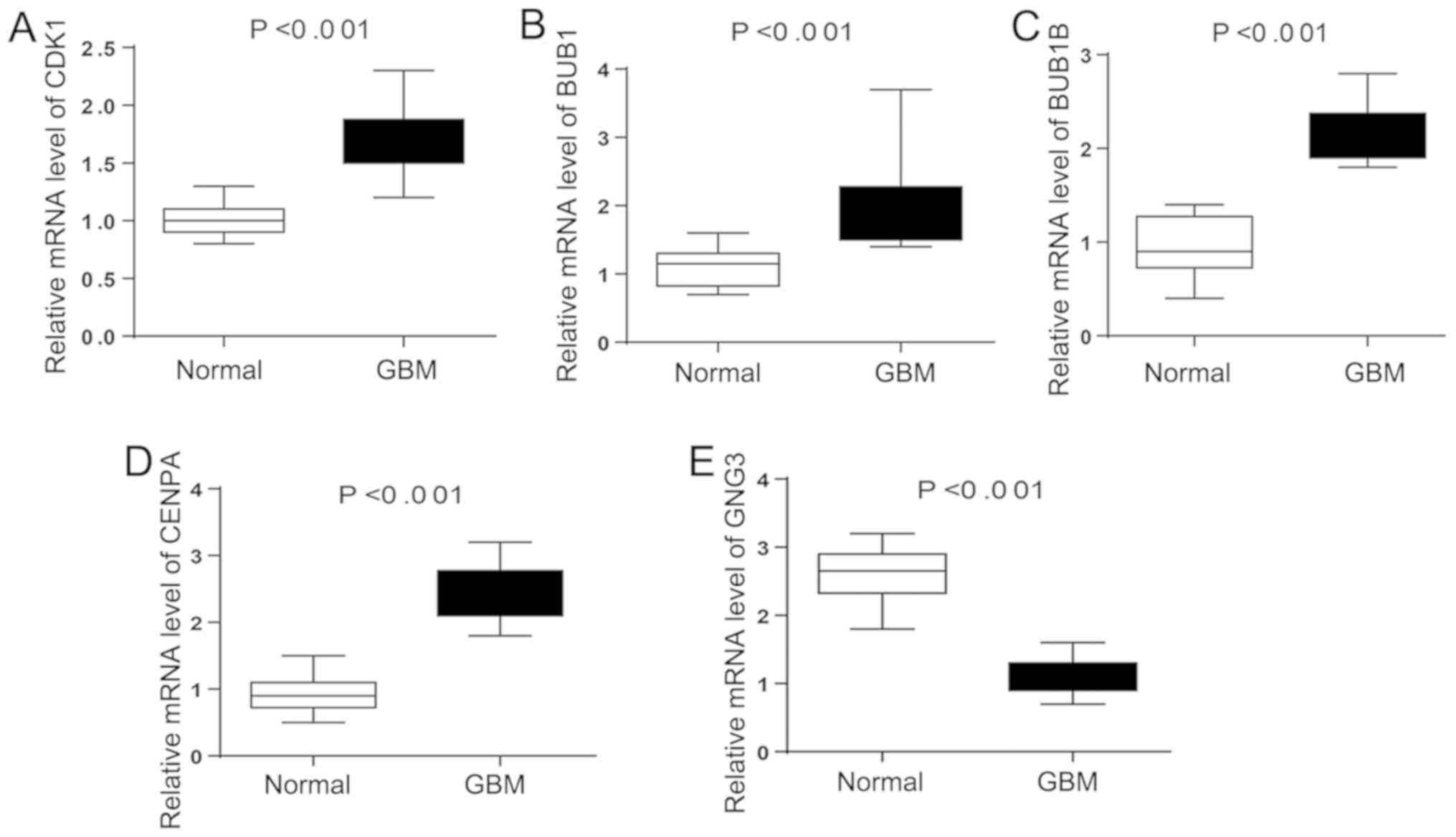|
1
|
Louis DN, Ohgaki H, Wiestler OD, Cavenee
WK, Burger PC, Jouvet A, Scheithauer BW and Kleihues P: The 2007
WHO classification of tumours of the central nervous system. Acta
Neuropathol. 114:97–109. 2007. View Article : Google Scholar : PubMed/NCBI
|
|
2
|
Louis DN, Perry A, Reifenberger G, von
Deimling A, Figarella-Branger D, Cavenee WK, Ohgaki H, Wiestler OD,
Kleihues P and Ellison DW: The 2016 World Health Organization
classification of tumors of the central nervous system: A summary.
Acta Neuropathol. 131:803–820. 2016. View Article : Google Scholar : PubMed/NCBI
|
|
3
|
Kloosterhof NK, de Rooi JJ, Kros M, Eilers
PH, Sillevis Smitt PA, van den Bent MJ and French PJ: Molecular
subtypes of glioma identified by genome-wide methylation profiling.
Gene Chromosomes Cancer. 52:665–674. 2013.
|
|
4
|
Rao SS, Lannutti JJ, Viapiano MS, Sarkar A
and Winter JO: Toward 3D biomimetic models to understand the
behavior of glioblastoma multiforme cells. Tissue Eng Part B Rev.
20:314–327. 2014. View Article : Google Scholar : PubMed/NCBI
|
|
5
|
Alifieris C and Trafalis DT: Glioblastoma
multiforme: Pathogenesis and treatment. Pharmacol Ther. 152:63–82.
2015. View Article : Google Scholar : PubMed/NCBI
|
|
6
|
Yang B, Ma YB and Chu SH: Silencing SATB1
overcomes temozolomide resistance by downregulating MGMT expression
and upregulating SLC22A18 expression in human glioblastoma cells.
Cancer Gene Ther. 25:309–316. 2018. View Article : Google Scholar : PubMed/NCBI
|
|
7
|
Doan NB, Nguyen HS, Al-Gizawiy MM, Mueller
WM, Sabbadini RA, Rand SD, Connelly JM, Chitambar CR, Schmainda KM
and Mirza SP: Acid ceramidase confers radioresistance to
glioblastoma cells. Oncol Rep. 38:1932–1940. 2017. View Article : Google Scholar : PubMed/NCBI
|
|
8
|
Martinez R, Rohde V and Schackert G:
Different molecular patterns in glioblastoma multiforme subtypes
upon recurrence. J Neurooncol. 96:321–329. 2010. View Article : Google Scholar : PubMed/NCBI
|
|
9
|
Witthayanuwat S, Pesee M, Supaadirek C,
Supakalin N, Thamronganantasakul K and Krusun S: Survival analysis
of glioblastoma multiforme. Asian Pac J Cancer Prev. 19:2613–2617.
2018.PubMed/NCBI
|
|
10
|
Herrlinger U, Tzaridis T, Mack F,
Steinbach JP, Schlegel U, Sabel M, Hau P, Kortmann RD, Krex D,
Grauer O, et al: Lomustine-temozolomide combination therapy versus
standard temozolomide therapy in patients with newly diagnosed
glioblastoma with methylated MGMT promoter (CeTeG/NOA-09): A
randomised, open-label, phase 3 trial. Lancet. 393:678–688. 2019.
View Article : Google Scholar : PubMed/NCBI
|
|
11
|
Hashemi M, Hadjighassem M, Zali A and
Hashemi J: Tumoricidal effect of human olfactory ensheathing cell
mediated suicide gene therapy in human glioblastoma cells. Mol Biol
Rep. 45:2263–2273. 2018. View Article : Google Scholar : PubMed/NCBI
|
|
12
|
Chao CN, Yang YH, Wu MS, Chou MC, Fang CY,
Lin MC, Tai CK, Shen CH, Chen PL, Chang D and Wang M: Gene therapy
for human glioblastoma using neurotropic JC virus-like particles as
a gene delivery vector. Sci Rep. 8:22132018. View Article : Google Scholar : PubMed/NCBI
|
|
13
|
Nathanson DA, Gini B, Mottahedeh J,
Visnyei K, Koga T, Gomez G, Eskin A, Hwang K, Wang J, Masui K, et
al: Targeted therapy resistance mediated by dynamic regulation of
extrachromosomal mutant EGFR DNA. Science. 343:72–76. 2014.
View Article : Google Scholar : PubMed/NCBI
|
|
14
|
Zhou K, Yao H, Zhang X, Liu J, Qi Z, Xie
X, Xu X, Zhou Y, Yu Z, Wang Z, et al: Next generation sequencing
and molecular imaging identify EGFR mutation and amplification in a
glioblastoma multiforme patient treated with an EGFR inhibitor: A
case report. Oncotarget. 8:50305–50313. 2017. View Article : Google Scholar : PubMed/NCBI
|
|
15
|
Hatanpaa KJ, Burma S, Zhao D and Habib AA:
Epidermal growth factor receptor in glioma: Signal transduction,
neuropathology, imaging, and radioresistance. Neoplasia.
12:675–684. 2010. View Article : Google Scholar : PubMed/NCBI
|
|
16
|
Ji C, Guo H, Zhang P, Kuang W, Fan Y and
Wu L: AnnexinA5 promote glioma cell invasion and migration via the
PI3K/Akt/NF-κB signaling pathway. J Neurooncol. 138:469–478. 2018.
View Article : Google Scholar : PubMed/NCBI
|
|
17
|
Siebzehnrubl FA, Silver DJ, Tugertimur B,
Deleyrolle LP, Siebzehnrubl D, Sarkisian MR, Devers KG, Yachnis AT,
Kupper MD, Neal D, et al: The ZEB1 pathway links glioblastoma
initiation, invasion and chemoresistance. EMBO Mol Med.
5:1196–1212. 2013. View Article : Google Scholar : PubMed/NCBI
|
|
18
|
Liu J, Liu D and Yang Z and Yang Z: High
LAMC1 expression in glioma is associated with poor prognosis.
OncoTargets Ther. 12:4253–4260. 2019. View Article : Google Scholar
|
|
19
|
Yates AD, Achuthan P, Akanni W, Allen J,
Allen J, Alvarez-Jarreta J, Amode MR, Armean IM, Azov AG, Bennett
R, et al: Ensembl 2020. Nucleic Acids Res. 48:D682–D688.
2020.PubMed/NCBI
|
|
20
|
Robinson MD, McCarthy DJ and Smyth GK:
edgeR: A Bioconductor package for differential expression analysis
of digital gene expression data. Bioinformatics. 26:139–140. 2010.
View Article : Google Scholar : PubMed/NCBI
|
|
21
|
Anders S, McCarthy DJ, Chen Y, Okoniewski
M, Smyth GK, Huber W and Robinson MD: Count-based differential
expression analysis of RNA sequencing data using R and
Bioconductor. Nat Protoc. 8:1765–1786. 2013. View Article : Google Scholar : PubMed/NCBI
|
|
22
|
Warnes GR, Bolker B, Bonebakker L,
Gentleman R, Huber W, Liaw A, Lumley T, Maechler M, Magnusson A,
Moeller S, et al: gplots: Various R programming tools for plotting
data. R Package Version 2.4. 2009.
|
|
23
|
Dennis G Jr, Sherman BT, Hosack DA, Yang
J, Gao W, Lane HC and Lempicki RA: DAVID: Database for Annotation,
Visualization, and Integrated Discovery. Genome Biol. 4:P32003.
View Article : Google Scholar : PubMed/NCBI
|
|
24
|
Szklarczyk D, Franceschini A, Wyder S,
Forslund K, Heller D, Huerta-Cepas J, Simonovic M, Roth A, Santos
A, Tsafou KP, et al: STRING v10: Protein-protein interaction
networks, integrated over the tree of life. Nucleic Acids Res.
43:D447–D452. 2015. View Article : Google Scholar : PubMed/NCBI
|
|
25
|
Diaz-Montana JJ, Gomez-Vela F and
Diaz-Diaz N: GNC-app: A new Cytoscape app to rate gene networks
biological coherence using gene-gene indirect relationships.
Biosystems. 166:61–65. 2018. View Article : Google Scholar : PubMed/NCBI
|
|
26
|
Shannon P, Markiel A, Ozier O, Baliga NS,
Wang JT, Ramage D, Amin N, Schwikowski B and Ideker T: Cytoscape: A
software environment for integrated models of biomolecular
interaction networks. Genome Res. 13:2498–2504. 2003. View Article : Google Scholar : PubMed/NCBI
|
|
27
|
Chin CH, Chen SH, Wu HH, Ho CW, Ko MT and
Lin CY: cytoHubba: Identifying hub objects and sub-networks from
complex interactome. BMC Syst Biol. 8 (Suppl 4):S112018. View Article : Google Scholar
|
|
28
|
Bandettini WP, Kellman P, Mancini C,
Booker OJ, Vasu S, Leung SW, Wilson JR, Shanbhag SM, Chen MY and
Arai AE: MultiContrast delayed enhancement (MCODE) improves
detection of subendocardial myocardial infarction by late
gadolinium enhancement cardiovascular magnetic resonance: A
clinical validation study. J Cardiovasc Magn Reson. 14:832012.
View Article : Google Scholar : PubMed/NCBI
|
|
29
|
Chandrashekar DS, Bashel B, Balasubramanya
SAH, Creighton CJ, Ponce-Rodriguez I, Chakravarthi BVSK and
Varambally S: UALCAN: A Portal for Facilitating Tumor Subgroup Gene
Expression and Survival Analyses. Neoplasia. 19:649–658. 2017.
View Article : Google Scholar : PubMed/NCBI
|
|
30
|
Livak KJ and Schmittgen TD: Analysis of
relative gene expression data using real-time quantitative PCR and
the 2(-Delta Delta C(T)) method. Methods. 25:402–408. 2001.
View Article : Google Scholar : PubMed/NCBI
|
|
31
|
Li L, Chen X and Chen Z: Identification of
key candidate genes in dairy cow in response to escherichia coli
mastitis by bioinformatical analysis. Front Genet. 10:12512019.
View Article : Google Scholar : PubMed/NCBI
|
|
32
|
Watkins S and Sontheimer H: Unique biology
of gliomas: Challenges and opportunities. Trends Neurosci.
35:546–556. 2012. View Article : Google Scholar : PubMed/NCBI
|
|
33
|
Teng J, da Hora CC, Kantar RS, Nakano I,
Wakimoto H, Batchelor TT, Chiocca EA, Badr CE and Tannous BA:
Dissecting inherent intratumor heterogeneity in patient-derived
glioblastoma culture models. Neuro Oncol. 19:820–832.
2017.PubMed/NCBI
|
|
34
|
Bonavia R, Inda MM, Cavenee WK and Furnari
FB: Heterogeneity maintenance in glioblastoma: A social network.
Cancer Res. 71:4055–4060. 2011. View Article : Google Scholar : PubMed/NCBI
|
|
35
|
Xiao S, Yang Z, Lv R, Zhao J, Wu M, Liao Y
and Liu Q: miR-135b contributes to the radioresistance by targeting
GSK3β in human glioblastoma multiforme cells. PLoS One.
9:e1088102014. View Article : Google Scholar : PubMed/NCBI
|
|
36
|
Zhu J, Ye J, Zhang L, Xia L, Hu H, Jiang
H, Wan Z, Sheng F, Ma Y, Li W, et al: Differential expression of
circular RNAs in glioblastoma multiforme and its correlation with
prognosis. Transl Oncol. 10:271–279. 2017. View Article : Google Scholar : PubMed/NCBI
|
|
37
|
Song YC, Lu GX, Zhang HW, Zhong XM, Cong
XL, Xue SB, Kong R, Li D, Chang ZY, Wang XF, et al: Proteogenomic
characterization and integrative analysis of glioblastoma
multiforme. Oncotarget. 8:97304–97312. 2017. View Article : Google Scholar : PubMed/NCBI
|
|
38
|
Fourest-Lieuvin A, Peris L, Gache V,
Garcia-Saez I, Juillan-Binard C, Lantez V and Job D: Microtubule
regulation in mitosis: Tubulin phosphorylation by the
cyclin-dependent kinase Cdk1. Mol Biol Cell. 17:1041–1050. 2006.
View Article : Google Scholar : PubMed/NCBI
|
|
39
|
Malumbres M and Barbacid M: Cell cycle,
CDKs and cancer: A changing paradigm. Nat Rev Cancer. 9:153–166.
2009. View Article : Google Scholar : PubMed/NCBI
|
|
40
|
Malumbres M and Barbacid M: Mammalian
cyclin-dependent kinases. Trends Biochem Sci. 30:630–641. 2005.
View Article : Google Scholar : PubMed/NCBI
|
|
41
|
Nigg EA: Mitotic kinases as regulators of
cell division and its checkpoints. Nat Rev Mol Cell Biol. 2:21–32.
2001. View Article : Google Scholar : PubMed/NCBI
|
|
42
|
Li W, Liu J, Fu W, Zheng X, Ren L, Liu S,
Wang J, Ji T and Du G: 3-O-acetyl-11-keto-β-boswellic acid exerts
anti-tumor effects in glioblastoma by arresting cell cycle at G2/M
phase. J Exp Clin Cancer Res. 37:1322018. View Article : Google Scholar : PubMed/NCBI
|
|
43
|
Song Z, Pan Y, Ling G, Wang S, Huang M,
Jiang X and Ke Y: Escape of U251 glioma cells from
temozolomide-induced senescence was modulated by CDK1/survivin
signaling. Am J Transl Res. 9:2163–2180. 2017.PubMed/NCBI
|
|
44
|
Chen H, Huang Q, Dong J, Zhai DZ, Wang AD
and Lan Q: Overexpression of CDC2/CyclinB1 in gliomas, and CDC2
depletion inhibits proliferation of human glioma cells in vitro and
in vivo. BMC Cancer. 8:292008. View Article : Google Scholar : PubMed/NCBI
|
|
45
|
de Voer RM, Geurts van Kessel A, Weren RD,
Ligtenberg MJ, Smeets D, Fu L, Vreede L, Kamping EJ, Verwiel ET,
Hahn MM, et al: Germline mutations in the spindle assembly
checkpoint genes BUB1 and BUB3 are risk factors for colorectal
cancer. Gastroenterology. 145:544–547. 2013. View Article : Google Scholar : PubMed/NCBI
|
|
46
|
Bie L, Zhao G, Cheng P, Rondeau G,
Porwollik S, Ju Y, Xia XQ and McClelland M: The accuracy of
survival time prediction for patients with glioma is improved by
measuring mitotic spindle checkpoint gene expression. PLoS One.
6:e256312011. View Article : Google Scholar : PubMed/NCBI
|
|
47
|
Ma Q, Liu Y, Shang L, Yu J and Qu Q: The
FOXM1/BUB1B signaling pathway is essential for the tumorigenicity
and radioresistance of glioblastoma. Oncol Rep. 38:3367–3375.
2017.PubMed/NCBI
|
|
48
|
Lee E, Pain M, Wang H, Herman JA, Toledo
CM, DeLuca JG, Yong RL, Paddison P and Zhu J: Sensitivity to
BUB1B inhibition defines an alternative classification of
glioblastoma. Cancer Res. 77:5518–5529. 2017. View Article : Google Scholar : PubMed/NCBI
|
|
49
|
Tannous BA, Kerami M, Van der Stoop PM,
Kwiatkowski N, Wang J, Zhou W, Kessler AF, Lewandrowski G, Hiddingh
L, Sol N, et al: Effects of the selective MPS1 inhibitor MPS1-IN-3
on glioblastoma sensitivity to antimitotic drugs. J Natl Cancer
Inst. 105:1322–1331. 2013. View Article : Google Scholar : PubMed/NCBI
|
|
50
|
Kessler AF, Frombling GE, Gross F, Hahn M,
Dzokou W, Ernestus RI, Löhr M and Hagemann C: Effects of tumor
treating fields (TTFields) on glioblastoma cells are augmented by
mitotic checkpoint inhibition. Cell Death Discov. 4:122018.
View Article : Google Scholar : PubMed/NCBI
|
|
51
|
De Rop V, Padeganeh A and Maddox PS:
CENP-A: The key player behind centromere identity, propagation, and
kinetochore assembly. Chromosoma. 121:527–538. 2012. View Article : Google Scholar : PubMed/NCBI
|
|
52
|
Tomonaga T, Matsushita K, Yamaguchi S,
Oohashi T, Shimada H, Ochiai T, Yoda K and Nomura F: Overexpression
and mistargeting of centromere protein-A in human primary
colorectal cancer. Cancer Res. 63:3511–3516. 2003.PubMed/NCBI
|
|
53
|
Rajput AB, Hu N, Varma S, Chen CH, Ding K,
Park PC, Chapman JA, Sengupta SK, Madarnas Y, Elliott BE and
Feilotter HE: Immunohistochemical assessment of expression of
centromere protein-A (CENPA) in Human invasive breast cancer.
Cancers. 3:4212–4227. 2011. View Article : Google Scholar : PubMed/NCBI
|
|
54
|
Li YM, Liu XH, Cao XZ, Wang L and Zhu MH:
Expression of centromere protein A in hepatocellular carcinoma.
Zhonghua Bing Li Xue Za Zhi. 36:175–178. 2007.(In Chinese).
PubMed/NCBI
|
|
55
|
Downes GB, Copeland NG, Jenkins NA and
Gautam N: Structure and mapping of the G protein gamma3 subunit
gene and a divergently transcribed novel gene, gng3lg. Genomics.
53:220–230. 1998. View Article : Google Scholar : PubMed/NCBI
|
|
56
|
Schwindinger WF, Giger KE, Betz KS,
Stauffer AM, Sunderlin EM, Sim-Selley LJ, Selley DE, Bronson SK and
Robishaw JD: Mice with deficiency of G protein gamma3 are lean and
have seizures. Mol Cell Biol. 24:7758–7768. 2004. View Article : Google Scholar : PubMed/NCBI
|
|
57
|
El-Habr EA, Dubois LG, Burel-Vandenbos F,
Bogeas A, Lipecka J, Turchi L, Lejeune FX, Coehlo PL, Yamaki T,
Wittmann BM, et al: A driver role for GABA metabolism in
controlling stem and proliferative cell state through GHB
production in glioma. Acta Neuropathol. 133:645–660. 2017.
View Article : Google Scholar : PubMed/NCBI
|















